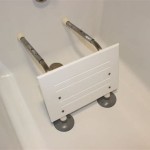Bathtub Faucet Diverter Stuck: Causes, Troubleshooting, and Solutions
A bathtub faucet diverter is a common mechanism designed to redirect water flow from the bathtub spout to the showerhead. Its function is essential for switching between taking a bath and showering. When this diverter becomes stuck, it can lead to significant inconvenience, preventing the user from effectively utilizing the shower or properly filling the bathtub. Understanding the potential causes, coupled with a systematic approach to troubleshooting and repair, can resolve this issue and restore the faucet's functionality.
The mechanics of a bathtub faucet diverter are relatively straightforward. Typically, a diverter is a small knob or lever located on the faucet spout. When activated, it closes off the passage to the tub spout and opens the pathway to the showerhead. The internal mechanism often involves a valve or a series of rubber seals that shift position to control the water flow. The longevity and proper function of this mechanism depend on several factors, including water quality, frequency of use, and the type of diverter installed.
Several types of diverter valves are commonly found in bathtubs. The most common include pull-up diverters, tee diverters, and rotating diverters. A pull-up diverter, often found directly on the tub spout, is activated by pulling a knob upwards. A tee diverter typically involves a lever that is rotated to switch the water flow. Rotating diverters often use a knob that turns to direct water up to the showerhead. Each type of diverter has its own design nuances and potential failure points, which must be understood when attempting to diagnose a problem.
Common Causes of a Stuck Bathtub Faucet Diverter
A stuck bathtub faucet diverter is a frequently encountered plumbing issue, and its causes can range from simple to relatively complex. Identifying the root cause is paramount to implementing the correct solution. Several factors can contribute to this problem, and careful observation is often necessary to pinpoint the exact reason for the malfunction.
Mineral buildup is a leading cause of diverter problems. Water, particularly hard water, contains minerals such as calcium and magnesium. Over time, these minerals can accumulate inside the faucet and around the diverter valve, creating deposits that restrict its movement. These deposits can harden, effectively cementing the diverter in place. The severity of mineral buildup depends on the water hardness in the area and the frequency with which the faucet is used. Regular cleaning and maintenance can help prevent this buildup from becoming a major issue.
Corrosion is another common culprit. Metallic components within the faucet, particularly in older models, are susceptible to corrosion. Exposure to water and chemicals can lead to rust and deterioration, which can seize the diverter valve. Corrosion can also cause the diverter components to swell, making it difficult to move the diverter lever. The type of metal used in the faucet’s construction plays a significant role in its susceptibility to corrosion. Brass and stainless steel are generally more resistant to corrosion than other metals.
Worn or Damaged Seals can also cause a diverter to stick. Diverter valves rely on rubber or silicone seals to create a watertight barrier and direct the water flow. Over time, these seals can degrade, crack, or become brittle, causing them to lose their effectiveness. Damaged seals can also cause the diverter to stick in one position, as the friction between the degraded rubber and the valve body increases. Furthermore, small pieces of the damaged seal can break off and lodge within the valve mechanism, further hindering its operation.
Physical Obstructions can also lead to a stuck diverter. Debris such as sediment, hair, or small particles can enter the faucet and become lodged around the diverter valve. These obstructions can physically block the diverter’s movement, preventing it from switching between the tub spout and the showerhead. Regular cleaning of the faucet aerator and spout can prevent debris from entering the system and causing problems with the diverter.
Troubleshooting a Stuck Bathtub Faucet Diverter
When a bathtub faucet diverter becomes stuck, a systematic troubleshooting process is necessary to identify the cause and determine the appropriate course of action. Starting with simple checks and gradually moving towards more complex solutions can often resolve the issue without the need for professional assistance.
The first step in troubleshooting is to visually inspect the diverter and faucet. Check for any obvious signs of damage, corrosion, or mineral buildup. Look for cracks or wear on the diverter knob or lever. Also, observe the faucet spout and showerhead for any signs of dripping or leakage, which could indicate a problem with the diverter valve. A careful visual inspection can often provide valuable insight into the nature of the problem.
Next, attempt to gently move the diverter. If the diverter is stuck, avoid applying excessive force, as this could damage the mechanism. Instead, try wiggling the diverter gently back and forth to see if it will loosen. Applying a penetrating lubricant, such as WD-40 or a similar product, to the diverter valve can also help to loosen any mineral deposits or corrosion that may be causing it to stick. Allow the lubricant to sit for several minutes before attempting to move the diverter again.
If the diverter remains stuck, the next step is to check the water pressure. Insufficient water pressure can sometimes prevent the diverter valve from properly engaging. Ensure that the water supply valves are fully open and that there are no other plumbing issues affecting the water pressure. If the water pressure is low, addressing the underlying plumbing problem may resolve the issue with the diverter.
If the previous steps do not resolve the problem, it may be necessary to disassemble the faucet and inspect the diverter valve directly. Before disassembling the faucet, shut off the water supply to the faucet to prevent flooding. Then, carefully remove the faucet handle and spout, following the manufacturer's instructions. Once the faucet is disassembled, inspect the diverter valve for mineral buildup, corrosion, or damage. Clean the valve thoroughly with a brush and a descaling solution to remove any deposits. If the valve is damaged, it may need to be replaced.
Solutions for a Stuck Bathtub Faucet Diverter
Once the cause of the stuck diverter has been identified through troubleshooting, several solutions can be implemented to resolve the issue. These solutions range from simple cleaning and lubrication to more complex repairs or replacements. The appropriate solution depends on the severity of the problem and the type of diverter valve involved.
Cleaning the diverter valve is often the first and most effective solution for addressing mineral buildup or debris obstructions. After disassembling the faucet, remove the diverter valve and inspect it for deposits. Soak the valve in a solution of vinegar and water or a commercial descaling solution to loosen the mineral buildup. Use a brush or a small tool to remove any remaining deposits. Rinse the valve thoroughly with clean water before reassembling the faucet.
Lubricating the diverter valve can help to improve its movement and prevent it from sticking in the future. Apply a small amount of plumber's grease or silicone lubricant to the valve and its moving parts. This will reduce friction and allow the valve to move more smoothly. Avoid using petroleum-based lubricants, as these can damage rubber or plastic components. Reassemble the faucet after lubricating the valve.
Replacing worn or damaged seals is essential for restoring the diverter valve's functionality. Inspect the seals for cracks, wear, or deterioration. If the seals are damaged, replace them with new ones of the correct size and type. Ensure that the new seals are properly seated and lubricated before reassembling the faucet.
If the diverter valve itself is damaged beyond repair, replacing the entire valve may be necessary. Diverter valves are available as separate parts or as part of a faucet repair kit. When selecting a replacement valve, ensure that it is compatible with the faucet model and that it meets all applicable plumbing codes. Follow the manufacturer's instructions for installing the new valve. If unfamiliar with plumbing repairs, consider seeking assistance from a qualified plumber.
Preventive maintenance can help to avoid future problems with the diverter valve. Regularly clean the faucet aerator and spout to prevent debris from entering the system. Periodically lubricate the diverter valve to keep it moving smoothly. Consider installing a water softener to reduce mineral buildup in the plumbing system. Taking these steps can help to extend the life of the diverter valve and prevent it from sticking in the future.

Diy How To Fix Shower Tub Stuck Spout Vinegar Diverter Bathtub

Trick To Remove That Stuck Tub Spout

Shower Tub Diverter Quick Fix Pull Spout Repair For Sticky Leaky

Diy How To Fix Shower Tub Stuck Spout Vinegar Diverter Bathtub

How To Free A Stuck Shower Faucet Spout

Loosen Your Tub S Stuck Faucet Diverter With This Handy Household Spray

How To Free A Stuck Shower Faucet Spout

Troubleshooting A Stuck Shower Faucet Diverter Doityourself Com

How To Fix A Stuck Bathtub Spout Leaking

How To Fix A Shower Diverter Repair Or Replace







